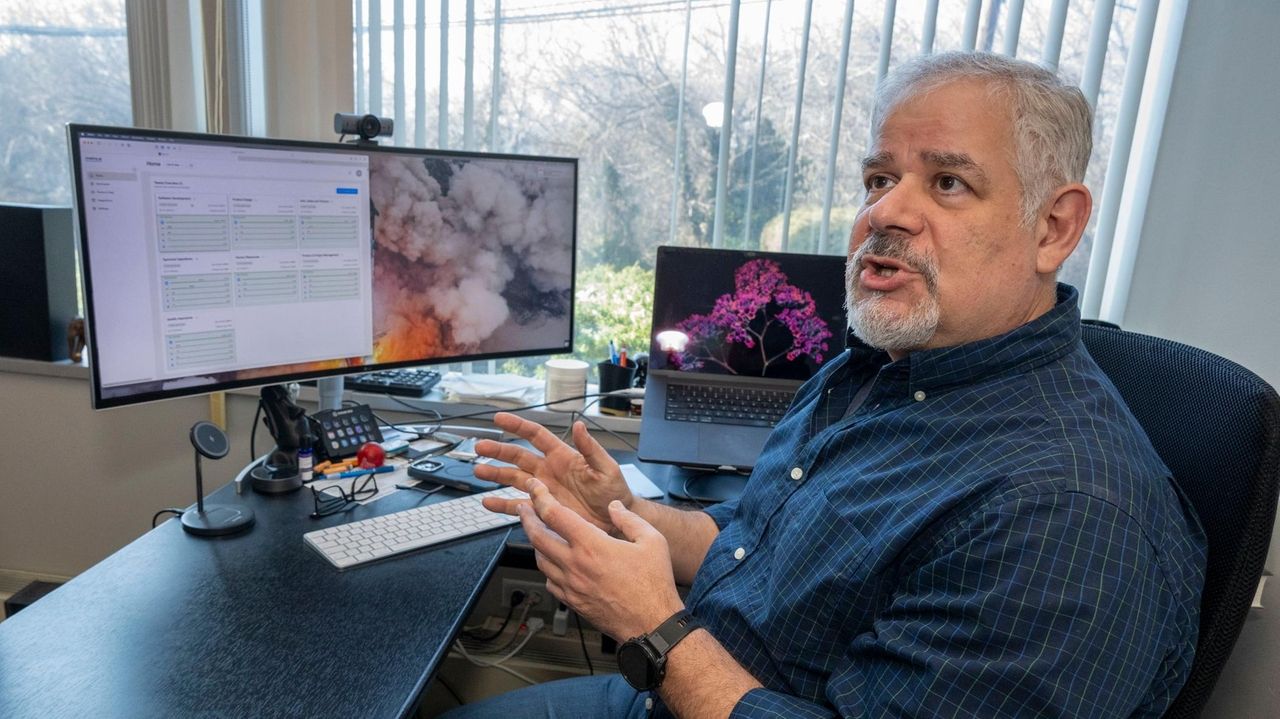Sitting in his small Plainview office, software developer Gus Spathis asks an artificial intelligence tool on his computer to produce code for a game As part of a demonstration.
He type the words: “Make a Tetris game in Python” in Claude 3.7 Sonnet, a coding AI developed by Anthropic.
Within 60 seconds, The software generated a full page with a code with a detailed explanation of the steps that AI has completed the task in English. Spathis, founder and CEO of the software development company Xogito, hit another key and a version of the Falling Block video game was on his screen.
Efficient tools such as Sonnet help its company, which makes adapted software and apps for small and large companies, speeding up software development. But it will entail costs, Spathis said, adding that AI will enable him to cut his 200-employee operation by 50% “while he gets more work done.”
What Nieuwsday has found
- Local technology companies say that AI tools are Increasing productivity among programmers by no less than 50%.
- Under technology companies rural88% use AI for at least one workplace function, with 39% used it for product development.
- Some technical employers said on Long Island They foreseen the reduction of the workforce by more than half, given progress in generative AI.
Long Island Technology companies say that generative AI tools such as Chatgpt, Meta’s Llama and China’s Deepseek enable companies to increase productivity – by 50% or higher – enable them to save money and time, but some employers also foreseen that personnel finishes are reduced due to AI’s productivity gain.
“In principle, increasing productivity is a good thing,” says Steven Skiena, professor of computer science and interim director of the AI Innovation Institute of Stony Brook University. But Skiena said it is clear that some jobs will be lost as AI increases efficiency.
“It is certainly a time of any disruption in the software industry,” he said.
Data: AI Use an evolving trend
Broadly speaking, the percentage of companies that used AI is growing, according to recently released data.
According to a study by McKinsey & Company in July 2024 and released in March, 78% of the respondents said that organizations use AI in at least one business function, an increase of 72% at the beginning of 2024, and 55% in 2023. The survey, which is in the income of the use of the uses and locations, also has the income.
According to the survey, the technical sector is the largest adoptor in the industry.
Among technology companies, 88% AI uses at least one workplace function, where 55% used it for marketing, 39% used for the development of products and services, and 36% the use of software engineering, according to the survey.
Moreover, 41% of employers are planning to reduce jobs, since AI automates work functions, according to a survey by the World Economic Forum that was released in January.
“AI has a major impact on how software companies think about programming and thinking about software,” said Skiena.
Anthropic CEO Dario Amodei said in March in an event of a Council of Foreign Relations that AI would probably write 90% of the code used by software employers within three to six months, according to media reports. A year from now on, Amodei said: “We may be in a world where AI essentially writes all the code.”
Productivity in the AI era
Skiena said that existing AI tools are increasingly getting better in performing many tasks that programmers would last weeks or months to reach, even if supervision and fixes are still required.
“You ask to generate a program to do something, and boom, it does it and it’s great,” he said. “It clearly has an effect and increases the productivity of people.”
The pace at which AI has improved in recent years has created both challenges and opportunities for local technology companies, said local managers.
Since the end of 2022, Chatgpt, owned by OpenAi, has undergone, for example, about a dozen large and small iterations. The AI company released its most recent version, GPT 4.5, in February. At the end of March, the Japanese conglomerate appreciated Softbank, according to recent reports OpenAI to $ 300 billion.
“Although we have been working with AI and process automation for years … there has been a very fast change in recent years,” says Raman Puri, vice -president of SVAM International Inc. from Great Neck, an IT service provider and software developer for government agencies and companies on Long Island.
Puri estimated that many software developers see everywhere from 50% to 75% increases to productivity when it comes to coding due to the speed of AI tools when generating lines of usable code.
That is why Puri said that SVAM “invests millions” in AI tools and training for employees.
Paul Trapani, co-founder of software developer Passtech Development LLC in Plainview, said that his small team has benefited enormously from tools such as Chatgpt, Meta’s Lama and Microsoft’s Copilot Chat Bot app.
“If a customer asks us if something is possible, we can use the AI to create a proof-of-concept program,” said Trapani, who also serves as President of the Long Island Software & Technology Network (Listnet), a local trade group.
“It is probably something that a capable developer could develop within a few hours, but AI generates it within a few minutes,” he said.
“It helps us to be a lot more productive with the staff we have instead of hiring extra people,” said Trapani, who employs around five employees locally and four others abroad.
Grow or lean?
Puri said that although SVAM’s staff of 800 employees, 400 in the United States and 400 in India, Mexico and Canada, the aim of the company has become to invest in AI in such a way that the company yields enough things to keep the personnel level the same.
“The economies of scale that larger companies can reach will be disproportionate to their advantage, and accordingly, small and medium -sized companies have a greater chance of being pressed,” Puri said.
“I have to invest disproportionately in this technology, so I re -balance the scales,” he said.
Regarding Spathis, the speed with which AI can perform tasks, it makes it clearer that his company must become slimmer in a busy market to stay competitive and to keep the costs low.
“With my existing set of employees, I have to find more things or the staff should reduce and that is a reality,” he said.
“We look at social disruption,” he said. “And we need the thinkers in our society to think deeply about dealing with this transition to minimize the impact of those people who cannot rearrange,” he said.









